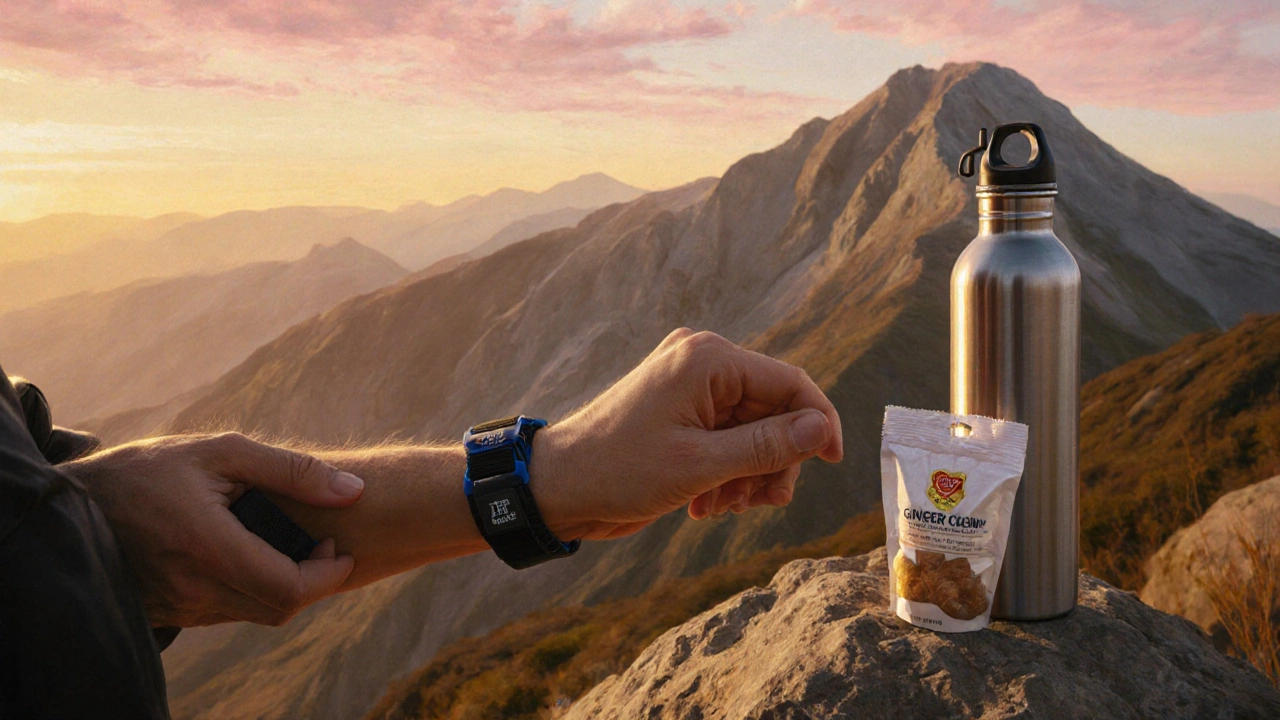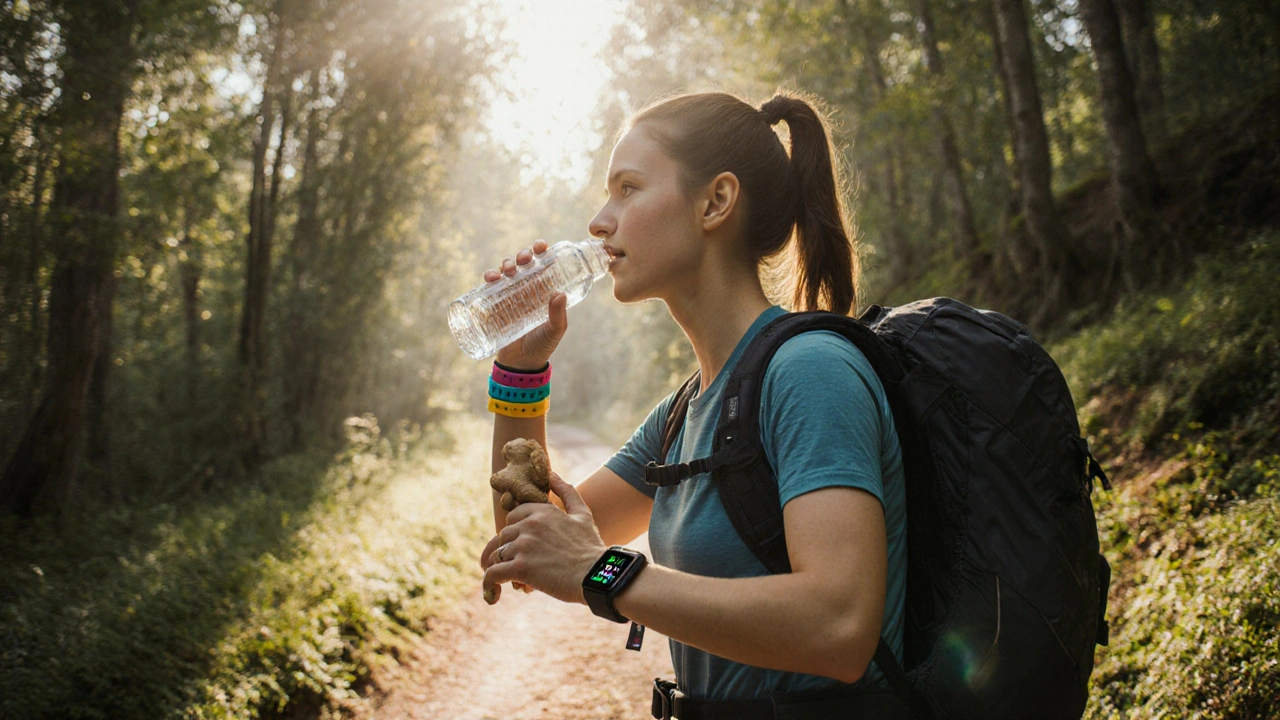29 Sep 2025
- 16 Comments
Hiking Hydration Calculator
This tool helps you calculate how much water and electrolytes you should consume during your hike to avoid dizziness and motion sickness.
Quick Take
- Stay hydrated and keep electrolytes in balance.
- Eat light, ginger‑rich snacks before and during the hike.
- Use acupressure bands or a simple pressure point technique if you feel queasy.
- Adjust your pace and take frequent shallow‑breathing breaks.
- Carry a small "symptom kit" with OTC meds, water, and a portable seat.
What’s Really Going on?
Dizziness is the sensation that you or your surroundings are spinning, tilting, or moving when they aren’t. It usually stems from a mismatch between visual input, the inner ear’s balance sensors, and the brain’s interpretation of motion.
When you add the uneven terrain of a trail, rapid altitude changes, and the exertion of hiking, that mismatch can spike, leading to motion sickness. The inner ear’s vestibular system, which detects angular acceleration, gets confused by the shifting visual cues of a forest path versus the actual movement of your body.
Why Hikers Get Queasy
Several trail‑specific factors turn a pleasant walk into a dizzy spell:
- Dehydration: Even mild fluid loss thins blood, reducing oxygen delivery to the brain’s balance center.
- Altitude: Lower oxygen levels at higher elevations trigger hypoxia, a common cause of light‑headedness.
- Uneven terrain: Rapid direction changes overload the vestibular system.
- Visual disruption: Dense tree cover or fog limits visual reference points.
- Skipping meals: Low blood sugar reduces energy for the brain’s processing.
Pre‑Hike Prevention Checklist
Getting ahead of the problem is easier than fighting it mid‑ascent. Follow this step‑by‑step routine before you lace up:
- Hydration plan: Aim for 2liters of water the night before, then sip 200ml every hour on the trail. Add an electrolyte tablet (sodium≈300mg) to each bottle to keep plasma volume up.
- Nutrition strategy: Eat a balanced meal 2‑3hours before you start - whole grains, lean protein, and a slice of fresh ginger or a ginger tea. Ginger contains gingerol, which has documented anti‑nausea properties.
- Acclimatization: If you’re heading above 2,000m, spend at least one night at a lower altitude, then ascend gradually (no more than 300m gain per day).
- Gear check: Pack a small "symptom kit" with water, a few ginger chews, an antihistamine like meclizine (25mg), and a lightweight acupressure band for the wrist.
- Mind‑body prep: Practice slow diaphragmatic breathing for 2minutes each morning for a week. Controlled breathing reduces vestibular overstimulation.

On‑Trail Relief Techniques
If the spin starts mid‑hike, you have several low‑tech options that work fast:
- Pressure‑point method: Press firmly on the inner forearm, three finger‑widths below the wrist crease (the P6 point). Hold for 30seconds; many hikers report instant calming.
- Acupressure band: Slip the band onto the left wrist, aligning the built‑in marker over the P6 point. It provides constant subtle pressure.
- Ginger boost: Chew a 1g piece of crystallized ginger or sip a ginger‑lemon tea. It takes about 5minutes to settle the stomach.
- Medication: If you’ve taken a pre‑emptive antihistamine, you may need a second 25mg dose after 4hours. Do not exceed 50mg total in 24hours without doctor approval.
- Controlled breathing: Inhale through the nose for a count of four, hold for two, exhale through the mouth for six. Repeat 5‑6 times while standing still.
While you’re performing these steps, find a stable spot to sit down, keep your head level, and focus on a distant point on the horizon - this gives the visual system a steady reference.
Gear & Supplies - The "Symptom Kit"
| Remedy | How it works | Typical dose | Pros | Cons |
|---|---|---|---|---|
| Ginger | Blocks serotonin receptors that trigger nausea | 1g fresh or 500mg extract | Natural, no sedation | May need frequent dosing |
| Antihistamine (Meclizine) | Stabilizes vestibular signals | 25mg orally, repeat after 4h | Long‑acting (up to 12h) | Drowsiness, not ideal for climbing |
| Acupressure band | Constant pressure on P6 point | Wear continuously | Non‑medicinal, reusable | Effect varies by individual |
| Hydration + electrolytes | Maintains plasma volume, prevents hypovolemia | 200ml water + 300mg sodium per hour | Essential for overall performance | Requires carrying fluid weight |
Pack these items in a zip‑lock bag that fits inside your daypack’s side pocket. Keep the bag above 10°C if you’re on a cold summit - cold fluids can worsen nausea.
When to Call for Help
If any of these red‑flags appear, stop and assess:
- Persistent dizziness after 30minutes of rest and hydration.
- Severe headache, blurred vision, or loss of coordination - could signal high‑altitude cerebral edema.
- Vomiting more than twice despite anti‑nausea measures.
- Chest pain, rapid heartbeat, or shortness of breath.
In those cases, use your emergency whistle, locate the nearest shelter, and if you have a satellite messenger, send an SOS. If you’re alone, descend to a lower altitude while staying hydrated.
Frequently Asked Questions
Can I prevent motion sickness without medication?
Yes. Hydration, ginger, acupressure bands, and paced breathing are proven non‑drug methods. For most people, they work best when combined and applied before symptoms start.
How much water should I drink on a 10‑km hike?
Aim for roughly 2liters total, plus an extra 200ml for every 30minutes of moderate climbing. Adjust upward if it’s hot or you’re at altitude.
Is meclizine safe for older hikers?
Meclizine is generally safe, but it can cause drowsiness, which may increase fall risk. Older hikers should start with a half dose and test it on a short walk before a longer trek.
What’s the best way to use an acupressure band?
Place the band on the left wrist, ensuring the marked bead sits directly over the P6 point (about two finger‑widths above the wrist crease). Wear it continuously; it does not need to be tight.
Can altitude alone cause dizziness?
Absolutely. At elevations above 2,500m, lower oxygen pressure can trigger hypoxia, leading to light‑headedness, headaches, and nausea. Proper acclimatization and staying hydrated are key.
Next Steps: Your Personal Dizziness‑Free Trail Plan
Take a few minutes tonight to write down the exact amounts of water, electrolytes, and ginger you’ll carry. Pack your "symptom kit" into a zip‑lock bag, and test the acupressure band on a short walk around the neighbourhood. By turning these actions into a checklist, you turn vague advice into a concrete plan that works on the trail.
Remember, the goal isn’t to eliminate every wobble - it’s to keep the wobble from turning into a stop‑sign. With a little preparation, you’ll stay on the path longer and enjoy the view without the spin.


luemba leonardo brás kali
September 29, 2025Staying hydrated is essential, especially when trekking at altitude where the body loses water faster.
Corey McGhie
September 30, 2025Oh, a hydration calculator-because nothing screams adventure like inputting numbers on a rocky ledge. Still, kudos for thinking ahead; a little planning beats a miserable wobble halfway up the ridge. Remember, the best “science” often comes from trial and error, not just spreadsheets.
Ajayi samson
October 1, 2025This guide reads like a corporate marketing brochure-full of buzzwords and zero real insight. If you wanted a boring lecture on water intake, good luck, you’ve got it. Anyone actually following this will just end up overpacking and lagging behind the pack.
Stephen Gachie
October 1, 2025Water is the river of life it flows through us and the mountain and we become its container in the endless climb the trail mirrors our inner quest for balance each sip a reminder of impermanence
Sara Spitzer
October 2, 2025Pretty much the same old advice you find on any generic hiking forum-drink water, eat ginger, use bands. Nothing groundbreaking here, just a rehash of standard tips with a fancy table. Saves me a few clicks but not much else.
Anshul Gandhi
October 2, 2025Did you ever notice how the “hydration plans” always push those salty electrolyte tablets? It’s a subtle way for big pharma to get us all hooked on their branded powders. They want us at altitude dependence so they can sell more product, especially when they partner with outdoor gear sponsors.
Emily Wang
October 3, 2025Imagine reaching the summit feeling clear‑headed, each step powered by the perfect balance of water and ginger. You’ve trained for this, you know the route, and now you’ve got a solid plan-go claim that view and prove to yourself you can master both the trail and your body.
Hayden Kuhtze
October 3, 2025Ah yes, the noble art of sipping water while the world spins-truly the pinnacle of human achievement. One might suggest a philosopher’s stone, but I suppose electrolytes will suffice.
Craig Hoffman
October 4, 2025When you head out on a multi‑hour hike, the first thing to secure is a reliable water source. A good rule of thumb is to start with at least two liters in your pack before you even leave the trailhead. From there, calculate your hourly loss based on temperature, altitude, and intensity of the climb. For every 30 minutes above 2000 meters, add an extra 100 ml of fluid to compensate for the thinner air. Electrolyte balance is just as critical as volume, because sodium helps retain the water you drink. A convenient method is to carry a small packet of sodium chloride or a pre‑made tablet that provides roughly 300 mg per liter. If you prefer natural sources, a pinch of salt mixed with a squeeze of lemon works surprisingly well. Ginger, whether fresh or in chewable form, acts on the stomach’s serotonin receptors and can blunt nausea before it starts. Many hikers find that chewing a small piece of crystallized ginger every hour keeps the queasy feeling at bay. Acupressure bands placed on the left wrist target the P6 point, a spot known in traditional medicine to stabilize the vestibular system. While the science is still emerging, anecdotal reports from seasoned trekkers suggest noticeable relief within five minutes of use. Breathing techniques, such as inhaling for four counts, holding for two, and exhaling for six, help regulate oxygen intake and reduce vestibular overload. Keep a simple checklist in your pocket: water, electrolytes, ginger, band, and a breathing cue. During the hike, pause every hour to sip, adjust your pace, and look toward a distant stationary object to give your visual system a reference. Following these steps will minimize the risk of dizziness, keep your performance steady, and let you enjoy the summit without the spin.
Terry Duke
October 5, 2025What a fantastic guide! I love the thoroughness! It really gives you confidence to tackle those steep climbs! Hydration and ginger are a power combo! Stay positive and keep moving forward! 🌄
Chester Bennett
October 5, 2025Combining the practical hydration calculator with simple breathing drills creates a well‑rounded strategy; it addresses both the physical and neurological triggers of motion sickness. Thanks for pulling the pieces together.
Emma French
October 6, 2025Skip the extra tablets and just drink plain water.
Debra Cine
October 6, 2025Great tips! 😊 Remember to pack your ginger chews and enjoy the trail with a smile! 🌟
Rajinder Singh
October 7, 2025Behold, the ascent where mortals confront the fickle whims of gravity and air; only the prepared may triumph over vertigo’s cruel whisper. Let the preparation be your armor.
Samantha Leong
October 7, 2025I understand the concern about commercial influences; it’s wise to scrutinize where our supplements come from and choose trusted, transparent brands.
Taylor Van Wie
October 8, 2025American adventurers deserve better than this nonsense-our trails belong to those who respect real preparation, not whiners.